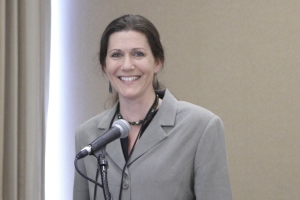February 11
The Language Tipping Point: Identifying the Drivers of Language Access
0 comments
February 11
0 comments

Language access in health care involves finding ways to ensure that language barriers do not affect health outcomes. Ms. Abraham focused first on building a case for health care systems to improve safety and quality of care for patients with limited English proficiency (LEP). She identified five important building stones: quality, risk management, compliance with federal and state law, equity and cost management.
Risk can’t be managed effectively without proper language access. Two leading causes of errors are deficient consent and inadequate medication instructions. Without a qualified medical interpreter, you do not have informed consent. These problems are disproportionate among LEP patients. Errors of clinical consequence can often be attributed to improperly trained interpreters. Abraham identified several hallmarks of poor communication leading to torts. One lawsuit, she said, would pay for many interpreters.
Federal and state laws that compel language access include Joint Commission requirements, Title VI of the Civil Rights Act, language access legislation in every state, and the Hill-Burton act of 1946.
Abraham cited a long list of costs attributed to lack of language access for limited English speakers. The list included entering the healthcare system in advanced and more costly stages of disease because of limited access to primary care, a higher likelihood of being hospitalized, and disproportionate use of emergency services.
Abraham also spoke about health inequalities. She told the story of Willie Ramirez, whose life was changed due to a mistranslated word, resulting in damages of $71 million dollars. (The story can be found at the Health Affairs Blog: “Language, Culture, And Medical Tragedy: The Case of Willie Ramirez” by Gail Price Wise.) Abraham pointed out that interpretation is recreating language live, as it happens. Without interpreters, there is no possibility for clarification — wrong meanings do not get changed.
Following an interactive exercise in which participants exchanged horror stories involving lack of language access at their places of work, Abraham wrapped up the session with four steps for creating a comprehensive language access plan. Enlisting champions from both the legal and finance departments is crucial. Ways of achieving long term solutions without project-killing expense include shared hires of interpreter and creating consortiums of HCOs who can negotiate bulk purchase of services.
But, she said, there are also ways to accomplish short-term solutions; creating a staff Language Access Task Force and Communication Plan, using over the phone interpretation, and video interpretation (her organization uses ipads).
Finally, she said, there are quick wins — specifically, there are steps to make phone interpretation work. They include staff training, instructions posted on phones for how to use phone interpreters, department “champions,” and concentration on high demand areas like the emergency room and family medicine. There are wonderful ways, she concluded, to make systems transformation in small steps.
Tags